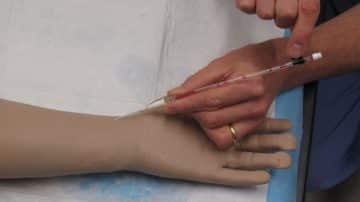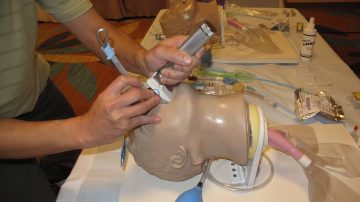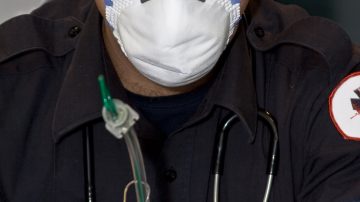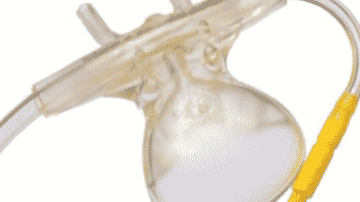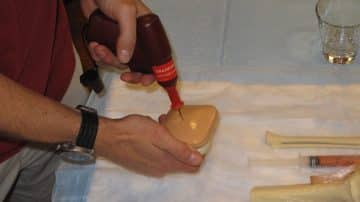Aggressive fluid administration is a hallmark of septic shock management and has been espoused by the Surviving Sepsis Campaign and is a part of the CMS SEP-1 sepsis bundle. The sepsis bundle includes administration of 30 ml/kg crystalloid bolus (LR…
Read MoreTOP TEN AIRWAY MANAGEMENT PEARLS TO OPTIMIZE YOUR CHANCES OF SECURING AN AIRWAY Develop a difficult airway management plan Huddle with your nurse and respiratory therapist in advance to alert everybody what plan A/B/C/D are for the patient If plan…
Read MoreA recent article summarizes a cross-sectional survey aimed at determining the processes in place to assess the procedural competency of academic emergency medicine attendings.[i] The survey was sent to the 39 ACGME-accredited Emergency Medicine programs in the U.S. and had…
Read MoreThe SARS-COV-2 pandemic started in January 2020 and has decimated the majority of U.S. hospitals for the past 18 months. The impact of COVID-19 has not only affected available hospital beds, but has limited the ability of hospitals to perform…
Read MoreThe American College of Physicians (ACEP) has previously published guidelines in October 2013 about Procedural Sedation and Analgesia. In these guidelines, they provided Level B recommendations that state, “Do not delay procedural sedation in adults or pediatrics in the ED…
Read MoreContinuous Capnometry Should be Standard Practice for Moderate-Deep Procedural Sedation Continuous capnometry has been consistently proven to identify patients undergoing moderate-deep procedural sedation who have impaired ventilation well before hypoxia develops. There have been at least 8 studies that have…
Read MoreThe Society of Airway Management recently issued guidelines for Difficult Airway Management in COVID-19 patients. The SARS CoV-2 (COVID-19) virus is extremely contagious via respiratory droplets and therefore extra precautions are needed for airway management in severe COVID-19 infection. Airway…
Read MoreVideo laryngoscopy is superior to direct laryngoscopy for emergency intubations in the ICU. A recent meta-analysis based on nine trials evaluated 2,133 ICU patients and concluded that video laryngoscopy (VL) has a higher first pass success rate compared to direct…
Read MoreIntraosseous vascular access using the EZ-IO device is a wonderful option for emergency access in the hospital or pre-hospital setting. Intraosseous lines are easy to place with proper training and can serve as emergency vascular access during cardiac arrest or…
Read MoreIntraosseous line use has increased significantly since the advent of the battery powered intraosseous drill. In surveying providers at courses over the years, we have seen a steady rise in the number of providers with access to the intraosseous drill. …
Read MoreMore Articles – Emergency Procedures, Events, Featured Procedure, medical procedures, Paracentesis, RUSH Exam
Rapid Ultrasonography in Shock: Is this really useful? Caring for patients with undifferentiated hypotension, causes anxiety for most health care providers. This is natural. Fear, however, must not lead to hesitation or poor decision-making. Therapies chosen early in shock disproportionately…
Read MoreMore Articles – Central line, Chest Tube, Emergency Procedures, Featured, Glidescope Intubation, Lumbar Puncture, Paracentesis, Thoracentesis
Medical procedural education in the era of COVID19 is still best conducted via HANDS-ON simulation-based procedural training. Procedural skills can NOT be attained via remote education, but in-person training must be conducted safely. There are many topics and skills that can be successfully be taught online,…
Read MoreEmergency department (ED) intubation is constantly evolving, with new devices, techniques, and medications being frequently adopted. To evaluate temporal trends, National Emergency Airway Registry (NEAR) investigators analyzed registry data on ED intubations at 13 large hospitals in the U.S., Canada,…
Read MoreVideo Laryngoscopy Is Superior to Direct Laryngoscopy for Failed Intubation Attempts in the ER Although video laryngoscopy has repeatedly been shown to be superior to direct laryngoscopy, there has not yet been any specific directive instructing emergency department (ED) intubators…
Read MoreThe traditional landmark-guided needle lumbar puncture technique was first described by Heinrich Quincke in 1891[1]This technique utilizes the iliac crest and the posterior lumbar spinous processes to determine the optimal sites for spinal needle introduction in either the L3-4 or…
Read MoreCategories
- ACLS (1)
- Arterial line (33)
- Cardiovascular diseases (77)
- Central line (55)
- Chest Tube (39)
- Dermatology (4)
- Emergency Procedures (139)
- Endocrinology (6)
- Endotracheal Intubation (36)
- Events (24)
- FAST Exam (12)
- Featured (113)
- Featured Procedure (42)
- Gastrointestinal diseases (32)
- Ginecology (3)
- Glidescope Intubation (21)
- Hematology (33)
- Hospital Procedures (85)
- Infections (32)
- Intraosseous line (8)
- King Tube (27)
- Laryngeal Mask Airway (18)
- Lumbar Puncture (36)
- Mechanical Ventilation (34)
- Medical General (95)
- medical procedures (258)
- Needle Decompression (6)
- Nephrology (11)
- Neurological diseases (12)
- Oncology (4)
- Paracentesis (32)
- Pericardiocentesis (3)
- Procedural Sedation (19)
- Respiratory diseases (85)
- RUSH Exam (8)
- Thoracentesis (37)
- Traumatology (24)
- Travel (27)
- Ultrasound-Guided Peripheral IV (13)

